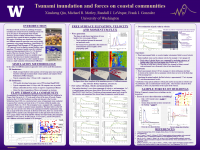CSDMS 2016 annual meeting poster XinshengQin
Comparison of 2D and 3D Numerical Models with Experiments of Tsunami Flow through a Built Environment
Abstract:
A series of tsunami wave basin experiments of flow through a scale model of Seaside, Oregon have been used as validation data for a 2015 benchmarking workshop hosted by the National Tsunami Mitigation Program, which focused on better understanding the ability of tsunami models to predict flow velocities and inundation depths following a coastal inundation event. As researchers begin to assess the safety of coastal infrastructures, proper assessment of tsunami-induced forces on coastal structures is critical. Hydrodynamic forces on these structures are fundamentally proportional to the local momentum flux of the fluid, and experimental data included momentum flux measurements at many instrumented gauge locations. The GeoClaw tsunami model, which solves the two-dimensional shallow water equations, was compared against other codes during the benchmarking workshop, and more recently a three-dimensional computational fluid dynamics model using the open-source OpenFOAM software has been developed and results from this model are being compared with both the experimental data and the 2D GeoClaw results. In addition, the 3D model allows for computation of fluid forces on the faces of structures, permitting an investigation of the common use of momentum flux as a proxy for these forces. This work aims to assess the potential to apply these momentum flux predictions locally within the model to determine tsunami-induced forces on critical structures. Difficulties in working with these data sets and cross-model comparisons will be discussed. Ultimately, application of the more computationally efficient GeoClaw model, informed by the 3D OpenFOAM models, to predict forces on structures at the community scale can be expected to improve the safety and resilience of coastal communities.
* Please acknowledge the original contributors when you are using this material. If there are any copyright issues, please let us know and we will respond as soon as possible.

